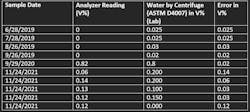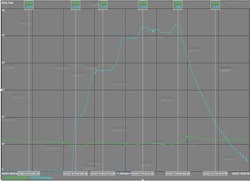- Installing an inline, static mixer to homogenize the oil and water mixture;
- Installing sample probes to provide a representative sample for the analyzer;
- Installing a lab-sample, take-off point within 1 m of the analyzer probe; and
- Correct sample point location to obtain a representative sample.
Continuous monitoring
The unit is designed so the fluid mixture flows through a fixed electrode assembly (Figure 1). This enables the dielectric constant of the mixture to be measured as a variable capacitance, which in turn produces an analog or digital output. This solution utilizes smart-sensor, data-analytics technologies in lieu of commonly used measurement techniques, and leverages built-in, artificial intelligence (AI) models. The accuracy is ±0.05% in the range from 0 - 1%. The analyzer is rated for an ambient temperature of 60 °C.
Advantages and limitations
Field test
Test criteria
- The water cut monitor reading value must be within ±0.05% water of the actual value determined by lab-sample analysis;
- The monitor must operate successfully within the upper environmental temperature limits listed in the monitor manufacturer’s specifications during summer’s ambient air temperatures and radiant heat conditions;
- The monitor must not show physical degradation or probe damage related to normal or abnormal operating conditions (provided the abnormal operating conditions don’t exceed the design conditions of the monitor);
- The monitor must not show signs of signal or measurement interference due to process background changes that may occur during normal or abnormal operating conditions (provided the abnormal operating conditions don’t exceed the design conditions of the monitor); and
- The monitor must operate reliably during the pilot period upon commissioning and must attain a 95% or greater online availability under normal and abnormal operating conditions (provided the abnormal operating conditions don’t exceed the design conditions of the monitor).
Results
It was observed that the water cut readings agreed with the lab for high readings at 0.8%. However, the reading didn’t agree sometimes in the range from 0 - 0.2 V%, which is explained by the fact that the ASTM D4007 (centrifuge) lab method has an accuracy ±0.1%. As stated previously, the analyzer has an accuracy of ±0.05% in a water cut range from 0 - 1%.
Response to changes in the process
- 9:33 a.m.—recovery pumps started and two high water wells were introduced;
- 9:41 a.m.—wash water increased from 1.5-1.7%
- 11:33 a.m.—recovery pumps switched offline
- 9:30 AM: 0.001 V%
- 10:23 AM: 0.22 V%
- 10:50 AM: 0.38 V%
- 11:20 AM: 0.53 V%
- 12:42 PM: 0.1 V%
Conclusion
About the Author
Ali S. Aldossary
Project Engineer, Saudi Aramco
Ali S. Aldossary is a project engineer in the oil facilities projects department at Saudi Aramco.

Leaders relevant to this article:



